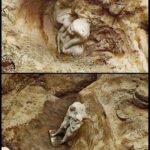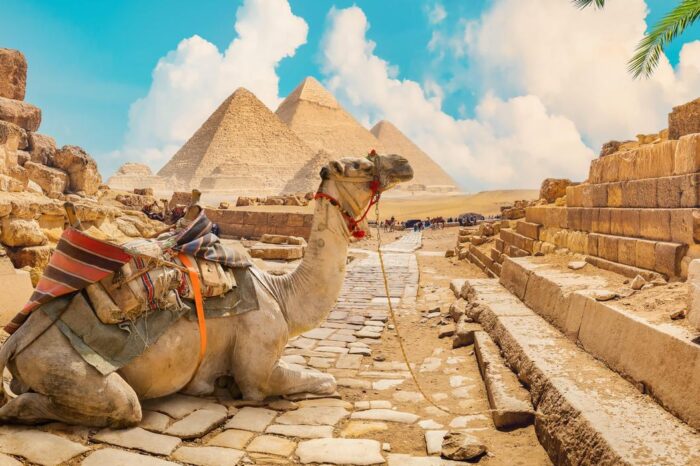-
Uncategorized
- Giza Pyramids ComplexMay 28, 2024
- THE DISCOVERY MOMENT OF KING'S MENKAURE AND HIS QUEEN'S...April 18, 2023
- Learn about five facts about the Philae Temple with...April 17, 2023
- Giza Pyramids Complex
Sharm El-Sheikh
Top-Rated Things to Do in Sharm el-Sheikh
Sharm el-Sheikh is the Sinai Peninsula’s major tourism center and one of the world’s top diving destinations.
It was the underwater tourist attractions of the Red Sea–particularly the waters of the Ras Mohammed Marine Park just south of town–that put “Sharm” center stage on Sinai’s tourism map in the first place, and for anyone planning an Egypt diving holiday, this is one of the best destinations in Egypt.

This is also one of Egypt’s best destinations if you just want to chill out on the beach. Non-divers will find plenty of land-based things to do, as Sharm is day-tripping distance to many of the Sinai Peninsula’s historic and natural sightseeing attractions.
It’s a particular favorite for family-friendly holidays due to the excellent facilities on offer. You can find a good selection of resorts in Sharm el-Sheikh.
Whether you’re here for the sand or the sea-life, Sharm el-Sheikh is a great choice for a beach break after exploring the temples and tombs in the rest of the country.
Plan your trip with our list of the top attractions and things to do in Sharm el-Sheikh.
______________________________________________________
1. Explore Ras Mohammed National Park

Ras Mohammed National Park is what put Sharm el-Sheikh on the tourist map.
Surrounded by some of the world’s most incredible dive sites, this peninsula, 38 kilometers south of Sharm, is home to glorious beaches with excellent snorkeling just offshore, the world’s second-most-northerly mangrove forest, and a saltwater lake.
While diving trips concentrate on the offshore reefs, land-based day trips to Ras Mohammed explore the peninsula’s desert environment and its beaches with swim and snorkel stops along the way.
The best beaches are Old Quay Beach (with its top-notch coral reef easily reached from the shore) and Aqaba Beach.
Travelers seeking a good view should head to the Shark Observatory cliff-top, right on the southern edge of Ras Mohammed, where views stretch across both sides of the Red Sea.
2. Dive the Thistlegorm Wreck

For many advanced divers, a trip to Sharm el-Sheikh means only one thing: diving the Thistlegorm.
One of the top wreck dives in the world and among the top places to visit in Egypt, this ship packed full of cargo to resupply British troops was sunk during World War II by German bombers.
Fish now flit through its rooms and cargo holds filled with jeeps, motorbikes, and armaments that never made it to the front.
The wreck is situated in the Straits of Gubal, off the western coast of the Sinai Peninsula, so diving trips are offered as overnight liveaboard tours.
These dive tours generally include at least two dives of the Thistlegorm wreck, plus dives at the Dunraven wreck (or one of Ras Mohammed’s dive sites) along the way.
Many also include night dive opportunities at the Thistlegorm site.
3. Soak Up the Sun at Naama Bay

Fringed by a white-sand beach and swaying palm trees, Naama Bay is the epicenter of Sharm el-Sheikh’s resort life.
There are plentiful restaurants, cafés, and souvenir stores if you get bored of the sand, but Naama Bay is really all about the beach.
A pedestrian-only promenade rims the entire beach area, backed by a cluster of luxury and mid-range resorts.
For those looking for a holiday full of sloth-like sunbathing, Naama Bay is one of Egypt’s best beaches.
The entire beach area has excellent facilities, including ample sun-shades and loungers, and the beachside cafés mean you don’t even have to move from your patch of sandy bliss all day.
Note that the entire sweep of beach here is sectioned into separate areas owned and run by the hotels, with complimentary access for resort guests.
When choosing your Naama Bay accommodation, especially if it’s not beachfront, always check what beach access they provide.
4. Dive the Jolanda Reef Site

Jolanda Reef (also called Yolanda Reef) is one of the most popular dive sites in the Ras Mohammed Marine Park area.
Dive trips here (accessed by boat from Sharm el-Sheikh) usually include Shark Reef as well, making this a two-for-one deal with a kaleidoscope of fish life and corals to be seen.
Jolanda Reef is home to the wreck of the Jolanda, an old Cypriot freighter ship that had been carrying a cargo of bathroom porcelain when it ran aground on the reef in 1980.
As well as the highlight of exploring the wreck site, the steep, rainbow-colored coral walls of Shark Reef that lead to the wreck, and Jolanda Reef’s coral garden plateau, are prime sea life spotting destinations.
Scorpionfish, crocodilefish, turtles, moray eels, and barracuda are all regularly spotted by divers here.
5. Snorkel off Ras Um Sid Beach

One of Sharm el-Sheikh’s best snorkeling destinations is Ras Um Sid Beach, right at the southern tail of the town, near the lighthouse.
Here, people slouch on the beach, or at the café on the cliff above, between snorkeling trips into the water, where an excellent coral reef is just offshore and so easily accessed by non-divers.
Farther away from the sand, Ras Um Sid Reef is perfect for first-time forays into diving and is used as a try-dive site by many local dive operators.
If you’re just here for the snorkeling, though, there is still plenty of variety of reef fish to see closer to the shore.
Address: Al-Fanar Street
6. Day Trip to Saint Catherine’s Monastery
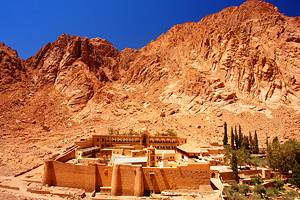
The Sinai Peninsula’s top historical destination, St. Catherine’s Monastery sits at the foot of Mt. Sinai, where Moses is said to have received the Ten Commandments.
One of the oldest working monasteries in the world, this Greek Orthodox hermitage is home to the famous “burning bush” of the Old Testament, which many of the Christian pilgrims who visit are specifically here to see. The bush is a rubus sanctus bramble that is native to the Sinai.
One of the highlights of a visit to Saint Catherine’s Monastery is the museum, which showcases a selected collection of some of the monastery library’s glittering cache of religious icons and ancient manuscripts. The library (not open to visitors) is renowned for containing one of the most important early Christian manuscript collections in the world.
The monastery is 209 kilometers northwest from Sharm el-Sheikh, within the Sinai’s barren mountainous interior.
Group tours from Sharm are offered both as overnight trips, including the hike up Mt. Sinai for sunrise, and as early morning departures to just visit the monastery.
7. Climb Mt. Sinai

Inland from the sun-drenched beaches of the coast, the Sinai’s rugged, mountainous heart is rawly beautiful.
For a taster of this craggy landscape, head 209 kilometers inland from Sharm el-Sheikh to hike up to the summit of Mt. Sinai to see an expanse of orange-hued peaks rippling out before you.
Revered by all three of the major monotheistic faiths as the place where Moses received the 10 Commandments, the summit hike is a pilgrimage for many people (and usually combined with a visit to St. Catherine’s Monastery, which sits at the trailhead for the hike).
There are two main trails up to the top. The Camel Trail is a well-worn switchback path, while the Steps of Repentance is a more difficult, but much more scenic, set of stone-cut staircases that was carved out by one of the monastery’s monks.
From Sharm el-Sheikh, most tours travel overnight to reach the trailhead in the wee hours of the morning so that the hike up the Camel Trail is completed in the cool, dark hours, and the summit is reached in time to watch sunrise over the surrounding peaks.
8. Relax on the Beach at Shark’s Bay

One of Sharm el-Sheikh’s newer resort development areas, Shark’s Bay sits 11 kilometers north from Naama Bay.
The vibe here is slightly more exclusive, with some of Sharm’s most luxurious five-star resorts and hotels clustered around Shark Bay’s sweep of sand.
As with Naama Bay, the beach areas are run by the individual hotels, which means facilities are well-kept and there are restaurants and cafés right on the sand. The snorkeling right off the shore, is also good here.
Behind the beach, the focus of Shark’s Bay life is the Soho Square Center. This mall complex is home to some of Sharm el-Sheikh’s top restaurant and café choices, as well as shops selling Egyptian craft work and other souvenirs.
In the evenings, Soho Square has a regular ‘dancing fountain’ display at its central fountain and plenty of various free family-friendly musical performances and entertainment. After dark the mall complex bustles with vacationers.
This means Shark’s Bay resort guests often choose to not move from this northern section of Sharm for their entire vacation.
9. Dive Jackson Reef

The Straits of Tiran, in the Red Sea’s Gulf of Aqaba, are home to some of Sharm el-Sheikh’s prime dive sites for experienced divers, and Jackson Reef is usually on most diver’s lists to cross off on a Sharm vacation.
This is the most northerly reef in the Straits of Tiran group, and it’s known for being one of the top spots in the area for hammerhead shark and manta ray sightings.
The reef is home to a plethora of soft and hard coral gardens, and advanced divers can also explore the wreck of the freighter Lara, which ran aground in 1981.
10. Snorkel or Dive the Blue Hole
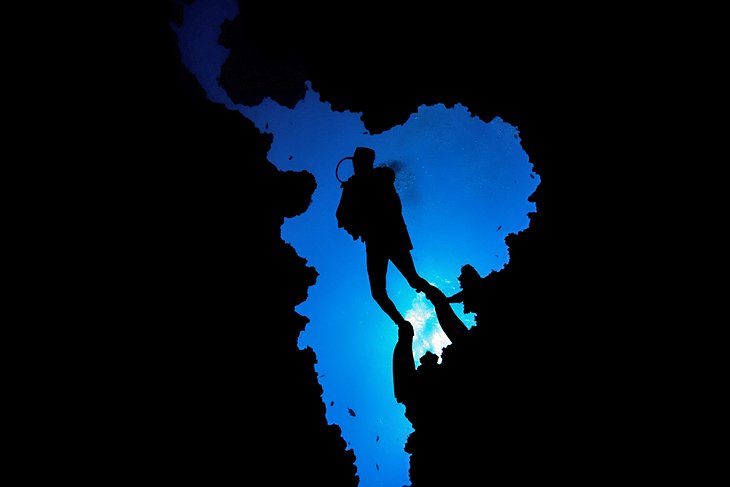
The Sinai’s most notorious dive site is the Blue Hole, just north of Dahab and 100 kilometers north from Sharm el-Sheikh.
This sinkhole’s infamy is due to the number of lives it has claimed, but all the deaths that have happened here are due to divers diving beyond the normal recreation diving limits.
Despite the site’s reputation for danger, divers who stick within sensible limits are perfectly safe here, and the fish life and incredible vistas of ethereal blue below make this an incredibly beautiful dive.
As the Blue Hole can be accessed from the shore, it’s also a popular snorkeling spot, with plenty of fish life to see flitting near the surface if you don’t fancy heading into the depths.
11. Day Trip to Dahab

Dahab, 90 kilometers north from Sharm el-Sheikh, is the Sinai’s backpacker beach resort and a chilled-out alternative to the holiday package feel of Sharm el-Sheikh.
The rocky shoreline here is lined with open-air cafés and restaurants, while a little shopping district winds its way up to the main highway in a jumble of souvenir shops.
There is some excellent diving and snorkeling here, with nearly all the local dive sites accessed from the shore, and most people who choose to base themselves in Dahab are here for a dive-centric vacation.
Dahab’s laid-back atmosphere, though, is also great for a day out from Sharm el-Sheikh.
12. Wreck Dive the Dunraven Site

The SS Dunraven had been traveling from Mumbai (then Bombay) back to the UK, when it hit the reef and sunk just off the tip of the Sinai Peninsula in 1876.
Today, this 80-meter steam ship, torn in two pieces on the sea floor, is home to a rich variety of fish, which have made their home within the barnacle-encrusted hull.
Divers here regularly spot big schools of colorful reef fish with cardinalfish, goatfish, scorpionfish, and pipefish all patrolling the area.
The boat trip to the dive site takes two hours from Sharm eI-Sheikh, so the Dunraven is often combined as either a day trip with one of the dive sites in the Ras Mohammed Marine Park area or as a stop along the way on an overnight liveaboard trip to dive the Thistlegorm wreck.
13. Shop at Sharm Old Market

Sharm Old Market (also known as Sharm al-Maya) is the town’s souq (bazaar) area, where twinkling Arabic lamps, traditional shisha pipes, and finely engraved woodwork can be found in abundance.
It’s best to come at sunset or later, when the worst heat of the day has dissipated, and you can shop and browse in comfort.
Egyptian craftwork is cheaper here than you’ll find in other Sharm el-Sheikh shopping destinations such as Soho Square and Naama Bay.
The area is full of inexpensive and cheerful restaurants and cafés as well, so it’s a good place to visit for dinner and a stroll in the evening.
This is one of the best areas in Sharm el-Sheikh to seek out classic Egyptian cooking, as the restaurants of the resort areas focus on more international fare. Head here for traditional café life complete with shisha and Arabic coffee as well.
On the edge of the market area is the new Al-Sahaba Mosque with an imposing facade that cherry-picks influences from Fatimid, Mamluk, and Ottoman mosque styles.
Non-Muslims are welcome to visit the mosque outside of prayer times, though the exterior architecture is the true highlight rather than the interior. After dark, the mosque is lit up, which makes for dramatic photos.
Address: Sharm al-Maya Road
14. Snorkel or Dive the Gardens Sites
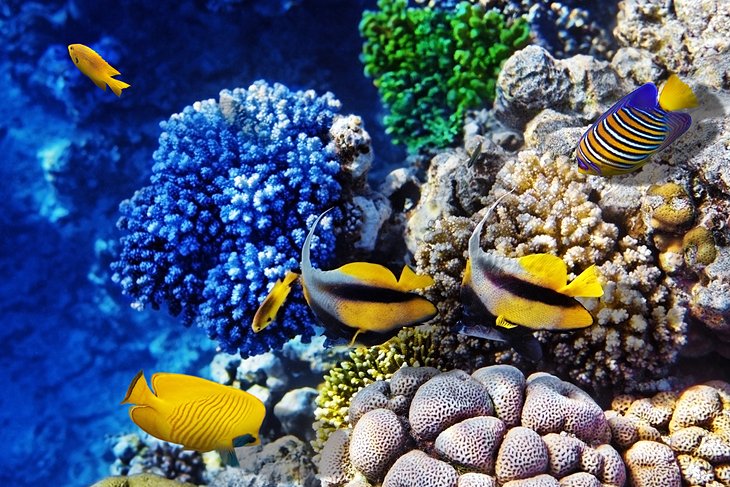
At the northern end of Naama Bay, the Gardens Reefs stretch out just offshore from the coast.
This reef system is actually three different snorkeling and diving sites called Near Garden, Middle Garden and Far Garden that can be accessed by both the shore and by boat.
If you just want to snorkel, Near Garden is the best (and easiest) site to access, and is home to some amazing coral pinnacles with plenty of flitting clownfish and butterfly fish in residence.
Far Garden and Middle Garden are often used as dive sites for beginners learning to dive, and provide an excellent taster of what the Sharm el-Sheikh area offers.
15. Dive Thomas Reef

Thomas Reef is the smallest reef in the Straits of Tiran and is renowned for its abundance of soft coral gardens.
Dive trips here are usually part of a boat day trip including one of the other Straits of Tiran Reefs–most often the neighboring Gordon Reef.
Due to the site’s strong currents, diving here is recommended for experienced divers. It’s also a popular site with technical divers, as the deep “three arches” area can be explored by advanced divers.
Plenty of fish life, including clownfish, pufferfish, and giant moray eels, can be spied while drift-diving along the site, and the rainbow-colored soft and branching corals are among the most pristine and vivid in the Red Sea.
16. Scramble around the Colored Canyon

The swirling mineral-rich layered rock formations of the aptly named Colored Canyon are one of the Sinai’s top out-of-the-water natural attractions.
The canyon, 177 kilometers north from Sharm el-Sheikh, is a showcase of the natural beauty of the desert, carved out of by millennia of wind and water whittling away the rock.
There are plenty of opportunities for visitors to scramble along the canyon path, accessing the rose-pink striped interior of the rock face.
For nature lovers, this is one of Sharm el-Sheikh’s top days out. Exploring the bizarrely-shaped pinnacles and boulders, which have been brushed with shimmering red and orange hues, offers up some fantastic photography opportunities.
Wear walking shoes with a decent tread if you want to visit, and bring along plenty of water.
17. Discover the Nature Reserve of Nabq Protectorate

Just to the north of Sharm el-Sheikh (around 20 kilometers from the central Naama Bay area), Nabq Protectorate is a coastal desert landscape of arid beauty and home to the world’s most northerly mangrove forest.
The landscape here inside this nature reserve is a vista of sand dunes, lonely beaches, and arak bushes, and it’s one of Egypt’s most important protected wilderness sites, with a huge amount of birdlife, as well as endemic gazelles and ibexes.
For snorkelers, the beaches here offer pristine reefs easily accessed from the shore, while inland, this is also a good area for hiking and cycling trips.
Connect to Us
Recent Tours
Why Egypt tours
Egypt Tours specializes in perfecting the meaning of vacation by proving countless variations of tours across the magical destinations of Egypt such as Cairo, Alexandria, Hurghada, Luxor, & Aswan. Every traveler will enjoy the finest hotel & Nile cruises and get a taste of what comfort is all about, a number of entertaining activities organized by the company will await every traveler to fully discover the wonder that it is Egypt.
Contact Info
-

